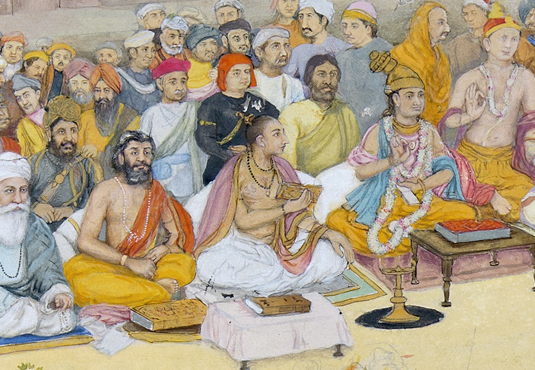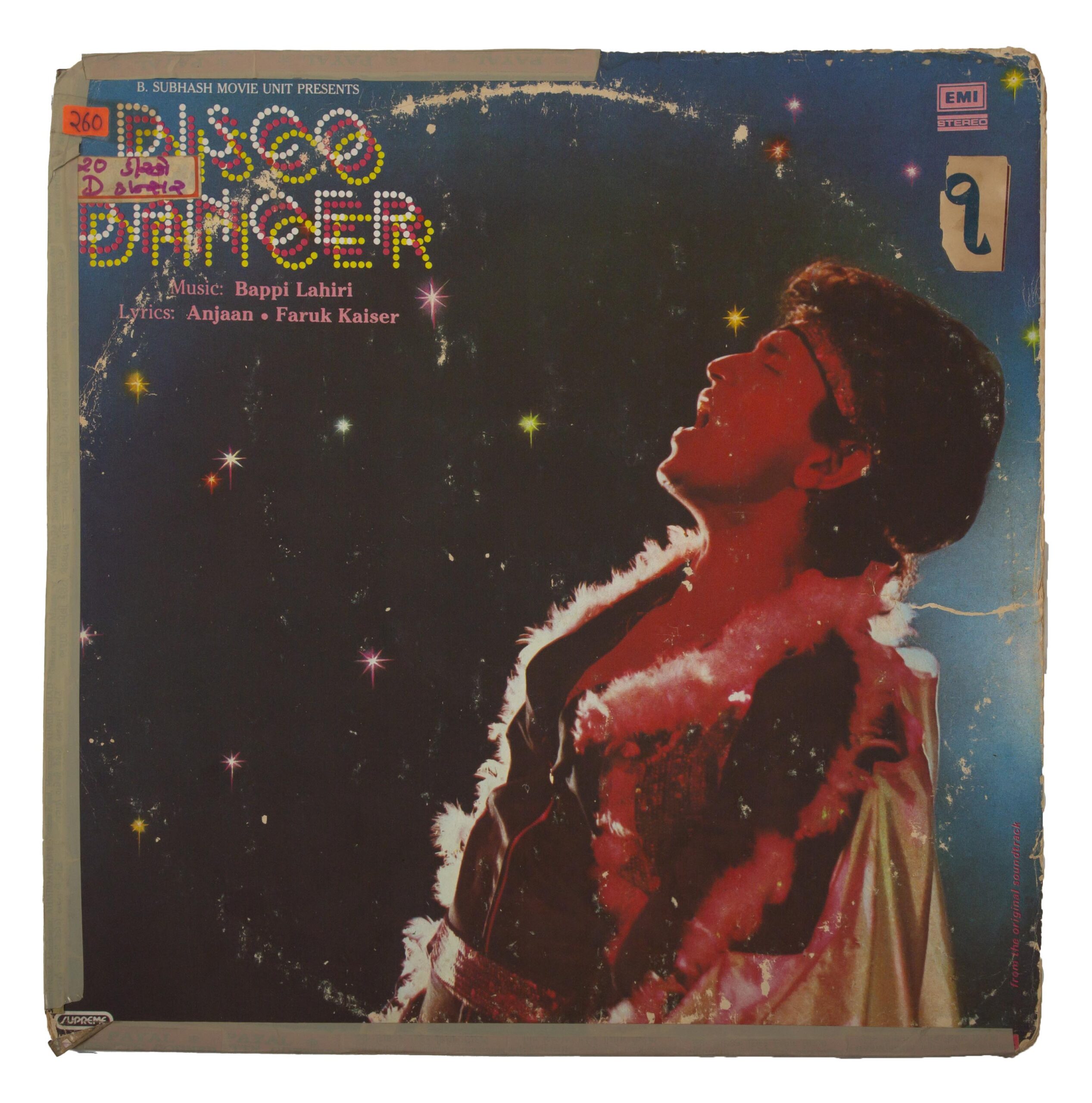Essays
A Conclave Unlike Any Other
Prof. BN Goswamy
Prof B.N. Goswamy takes readers on a comprehensive visual and literary journey through the painting, A Remarkable Conclave, depicting an imaginary gathering of thinkers, saints and poets such as Tukaram, Guru Nanak, Ramakrishna Paramahamsa, Tiruvalluvar, Narsi Mehta, Eknath, Namdev, Chandidas and other important figures.
Not infrequently, in Indian painting, one comes upon images of small groups of saintly men — sufis is how one generally sees them — seated in a circle at the centre of which there might be a low chauki-like table on which a small pile of books rests. These men, not young of years and often bearded, seem not necessarily to be conversing with one another: each of them appears lost in his own thoughts; one of them might sometimes even have a book in his own hands, one finger inserted in the volume like a bookmark, as if to suggest that he might soon start reading from the point where he had left off; another might be gazing into the distance, otherworldly look in the eyes; yet another might be sitting with legs folded, a rough woollen wrap around them; and so on. There is quietude in the atmosphere; nothing from outside impinges upon the group; there are no bustling devotees or disciples around: the men sit just by themselves, surrounded by a palpable sense of calm.
But while one gets lost in many ways in these wonderfully contemplative, withdrawn scenes, one does not even notice that there is something unusual about them. And that is that there is no way in which, in real life, these men could have come together. The figures — not true but idealised portraits — are most often drawn from different periods, and different places. In the group, thus, might be Shaikh Farid-ud-din sitting next to Khwaja Bakhtiar Kaki; Nizam-ud-din Aulia might have Shah Sharf Bu Ali Qalandar perched on the floor next to him; Hazrat Dastgir might be casting a benign eye at Khwaja Moin-ud Din Chishti from close by: personages whose dates might range from the 12th century to the 18th century; whose places might be as far away from one another as Pak Pattan is from Delhi, or Srinagar is from Bijapur. What explains all this, then, these strange comings together? Possibly — and this is just a speculation — in these paintings, the painters are raising a suggestion that these saintly men are free of the bonds of time, or the constraint of space; that they belong to all time and all space. It is their collective auspiciousness that needs to be evoked.
Whatever the case, I bring all this in to provide a background to a very unusual painting, an astonishing patriotic fantasy one might say, that came to my notice just a few weeks ago. It shows a large, very large gathering of people of all descriptions, many of them seated under a huge pandal: textile awning supported by sturdy poles that seems to have been set up in the courtyard of a sprawling, palace-like structure.

Detail of A Remarkable Conclave, c. 1950, Watercolour on paper, MAP
The heart of the space covered by the pandal is bare except for two large metal receptacles in which fire is seen burning, as if someyajna were in progress although no one is pouring any libations into it. And all around that empty, almost reverentially left vacant space, are seated in row upon row men — iconic figures that loom in every Indian’s memory — some of them with books resting in front of them, others holding texts in their hands, still others with arms raised in the air as if either reciting or responding to some recitation.
These are personages — men of faith, and of learning, but pointedly no political figures — belonging to different periods and different spaces, like the Sufis whom I have described earlier, and one is startled to see them all together.
Some faces one can recognise at sight because one is familiar with their features as popularly perceived or painted; others are identified through scattered inscriptions, many of them pencilled in Urdu on the body of the painting itself, others in English characters on the margins of this large water colour. One has to get close to the work to read faces and inscriptions but there are many whom one can identify at sight. One sees thus Guru Nanak, seated cross-legged; next to him is Ramakrishna Paramhamsa — identified in the inscription as Gadadhar Chattopadhyaya, his real name; at some distance but in the same row, is Kabir recognisable from the peacock feather in his cap; a little further is Tyagaraja holding a stringed instrument.

Detail of A Remarkable Conclave, c. 1950, Watercolour on paper, MAP
In another row, one can recognise the great blind poet, Surdas, with clappers in his hands, singing; Swami Vivekanand appears in his ochre robes at one place; in a balcony at the very back sits a princess — away from the crowd — who is almost certainly Mirabai; towards the right and once again not part of the groups that sit in rows, is Rabindranath Tagore surrounded by followers. The list is endless, for the inscriptions identify other celebrated and revered men who come from the length and breadth of India: thus, Tukaram, Tiruvalluvar, Narsi Mehta, Eknath, Namdev, Chandidas.
Just as one starts getting used to these faces and names, one comes upon a whole range of poets of the distant and the immediate past: Abdul Rahim Khan-khanan, Ras Khan, Keshavadas, Bihari, Bhushan, and those celebrated Hindi writers whose works were on so many lips in times not many days back: among them, Bharatendu Harishchandra, Sumitranandan Pant, Mahadevi Verma, Suryakant Tripathi Nirala, Jai Shankar Prasad, Subhadra Kumari Chauhan.
But it does not end here. All this is where the gathering is orderly, and everyone seems to be listening to everyone else. Around that, and outside the pandal, is a wonderful but almost raucous mela-like gathering of ‘hundreds’ of men, women and children among whom, at one place, Chaitanya Mahaprabhu is seen dancing his mystic dance; Mirza Ghalib walks by two men holding each other’s hands; a mulla, with his hand raised heavenwards as if declaring that there is only one God argues with a pandit, and so on.

Detail of A Remarkable Conclave, c. 1950, Watercolour on paper, MAP
In the crowd one sees people of all communities, belonging to every part of India: Hindus and Muslims and Sikhs, Parsis and Bohras, Brahmins and Dalits, Jats and Pathans; not this alone: the costumes that one sees come as much from Akbar’s India as from the land of the Cholas. It is as if the painter — who has astonishingly painted each face as if it were an observed portrait — were intent upon creating a microcosm of India. There is love of poetry and a sense of national pride that shines through the work, and the statue of the pointedly ignored Imperial British lion at one end of the painting seems to snarl to no effect. Who could the painter have been? Who might have commissioned the work? What was the intent? Are we reading it right? One has virtually no answers.








